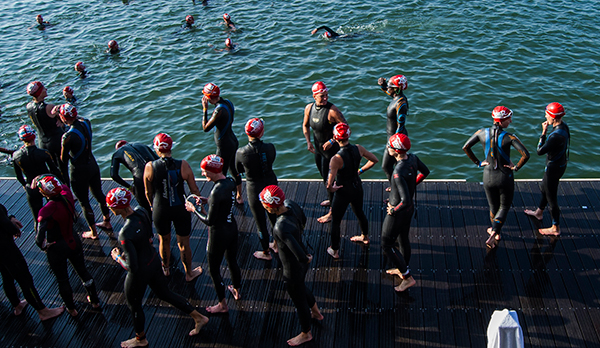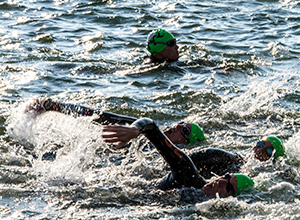
When thousands of athletes plunged into Lake Michigan for the swimming portions of the 2014 USA Triathlon Olympic-Distance National Championships in Milwaukee Aug. 9-10, they knew exactly what they were diving into.
Thanks to careful water quality monitoring by UWM assistant professors Todd Miller and Matthew Smith, athletes had access to up-to-the-minute water temperature and bacteria level measurements. Miller teaches environmental and occupational health in the Joseph J. Zilber School of Public Health. Smith teaches in the School of Freshwater Sciences.
 “When the event was held in Milwaukee in 2013, I was asked by the Milwaukee Health Department to sample and monitor water quality for the swim course,” Miller said. Despite significant worries by contestants, Miller was able to confirm the water was free of E. coli and other contaminants, thereby green-lighting the event. As a helpful bonus last year, Miller also provided temperature measurements, which he said ultimately turned out to be as valuable to the athletes as the bacteria information.
“When the event was held in Milwaukee in 2013, I was asked by the Milwaukee Health Department to sample and monitor water quality for the swim course,” Miller said. Despite significant worries by contestants, Miller was able to confirm the water was free of E. coli and other contaminants, thereby green-lighting the event. As a helpful bonus last year, Miller also provided temperature measurements, which he said ultimately turned out to be as valuable to the athletes as the bacteria information.
“A lot of variables are dictated by water temperature,” Miller said. “The decision to wear a wet suit or not affects performance, as does wet suit thickness. The temperature can vary depending on factors like wind direction, wave direction, storm water and upwelling, which occurs when deeper water rises to the surface.”
Miller said water temperature in the race area can vary quite a bit from the surface on down. “It can be 1 to 3 degrees Celsius of change, but you’d definitely feel it,” he said.
Race organizers specified their desired temperature measurement be taken 18 inches below the surface, but the UWM professors provided even more information.
“We essentially took temperature sensors, waterproofed them and measured nautical temperature at five different depths,” said Smith, who was brought on board by Miller for this year’s triathlon. “We put the temperature information on a website, which athletes accessed for real-time results.”
Triathletes swam in water that averaged 13-feet deep in an area bordered by Discovery World, the Summerfest grounds and Lakeshore State Park, near Summerfest’s shore. Saturday’s event featured a 1,500-meter swim, 40-kilometer bike and 10-kilometer run, while Sunday’s sprint race involved a 750-meter swim, 20-kilometer bike and 5-kilometer run. The top 25 finishers in each age group qualified for the 2015 International Triathlon Union World Championships in Chicago.
Collaboration on the triathlon water testing project evolved from a three-year-old partnership between UWM and the Milwaukee Health Department to monitor the health of area beaches. UWM routinely samples water at Milwaukee’s Bradford, McKinley and South Shore Beaches, and both organizations perform chemical analysis.
“The main microbiology test we do is to measure the abundance of E. coli,” Miller said. “Some strains are harmful to people, and it is a good indicator for sewage input and the potential for other harmful bacteria.”
In addition to checking for E. coli, Miller and his team monitor algae levels.
“The primary influence on water quality is cladophora, the green algae that ends up decaying on the beach,” Miller said. “If the water gets too warm, cladophora starts to die and smells bad.” Miller also tested the swim course water for blue-green algae toxins, which were appearing in other Great Lakes in early August and were a concern of athletes coming to Milwaukee from around the country.
“I knew it was very unlikely blue-green algae toxins would be here,” Miller said. “It’s just too cold for that kind of algae in this area. As far as I know, there has never been a recorded incident of toxic blue-green algae in Lake Michigan at Milwaukee or Chicago. However, there can be algae that is not toxic.”
Smith said he and Miller are working to develop prototypes of inexpensive sensors to obtain water quality measurements, like those for water turbidity, or cloudiness.







